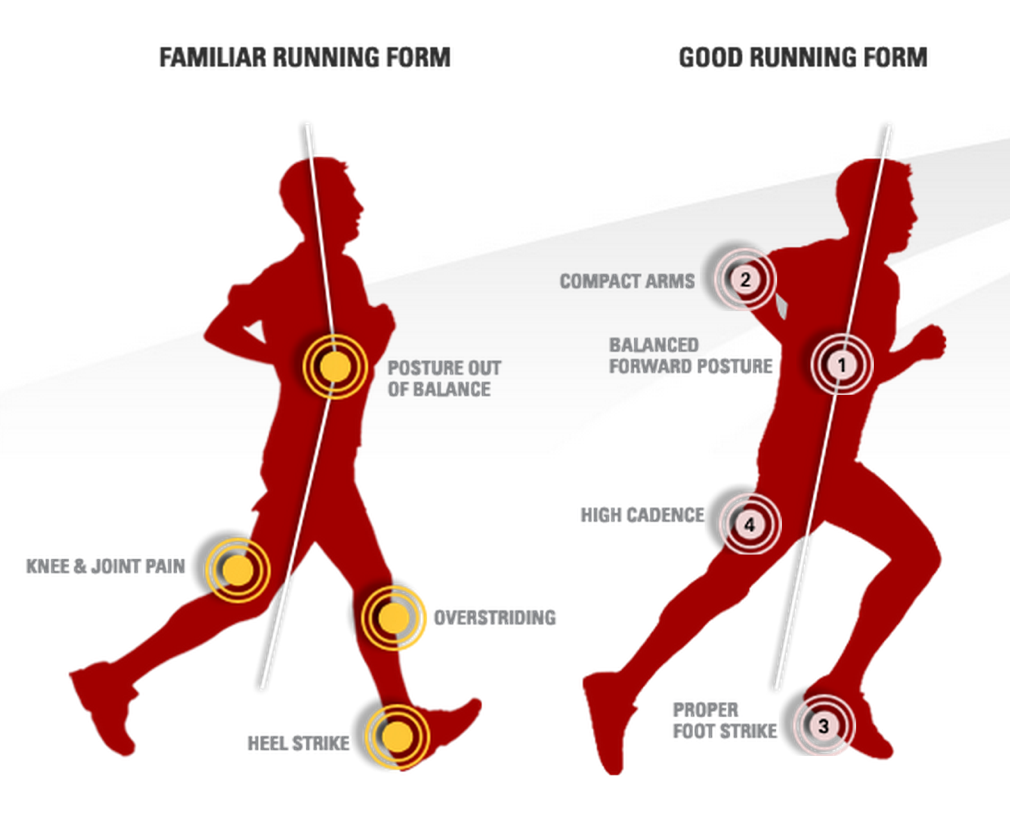Top 5 Running Form Mistakes
Runners love to run. Regarding health and longevity, running is an amazing way to live a longer more active life. Research has shown that running as little as 5-10 minutes per day decreases all-cause mortality by 30% and risk of cardiovascular incidents by 45% adding up to 3 years to your lifespan. This doesn’t include the numerous benefits runners get in their mental health. Despite all of those benefits, so few recreational runners know how to run properly. Changing your running form is one of the best ways to improve your running efficiency or rehab a running related injury.
What is Proper Running Form?
Running form is a highly debated topic among coaches and athletes. When you run, your body needs to absorb the force of the ground with each step you take. For example, walking puts the force of 3-4x your bodyweight through your knee joints while running puts the force of 6-8x bodyweight. So proper running form requires movement and coordination for optimal force absorption. The barefoot running revolution was started after Christopher McDougall’s Book Born to Run wrote about an indigenous tribe in Mexico who all had an amazing ability to run at high speeds and long distances with smooth force absorption mechanics. As our modern American lifestyle becomes more sedentary, the worse our bodies become at running. While multifactorial, most people don’t walk, run, or lift heavy things which build up tolerance to allow your body to absorb force. To accommodate for a more sedentary lifestyle, the Hoka revolution has produced a bigger/more cushioned shoe each year to help you run. Our sedentary lifestyle and daily footwear has set you up to run poorly, what is proper running form?
Running is a complicated human skill and requires proper foot contact, cadence (steps per minute), forward lean, and push off. In the image below, you can see when the foot lands in front your body, there is a very high force going thru the body akin to putting the brakes on each step you take. Many elite runners use a Cadence of 180 steps per minute because the more steps you take, the more the force can evenly be absorbed. This is the opposite of what I was told my entire athletic carrear. Being as I’m 6’2'“, I was told to take big long steps which led me to get shin splints every basketball season. When it comes to running cadence, anything <162 steps per minute puts you at significant risk of injury and should be increased. A proper lean forward will help momentum drive your bodyweight forward and make you more efficient while absorbing force. Any runner with back pain is likely like the runner on the left of the image with limited midline core stability and an exaggerated curve in the low back. Proper push off requires hip mobility and hamstring/gluteal muscle strength but more on that later.
Before you learn about running form mistakes, it’s important to note that each person will run slightly differently and may have histories that require deviation from proper form. For example, heel striking or overstriding is the most common fault causing high force going into the body and can lead to injuries. However, runners battling Achilles Tendon problems will feel better heel striking because it puts less force into the Achilles/Calf and more force into the heel bone and knee.
Photo Credit: Simon Brooker Coaching
So what are the Top 5 Running Form Mistakes?
Overstriding
By far the most common running form mistake seen in recreational runners. The quote I use in the Running Lab frequently is “everybody’s a heel striker until they aren’t.”
Meaning that most Overstride until their body can’t handle the force and an injury occurs.
If this is you, thinking about where your foot hits the ground typically makes running more uncoordinated or you will become a toe runner which will destroy your calf muscles. Instead think about “driving your knee forward.”
Image Credit: Run DNA
Collapsing
The classic sign of collapsing is when the foot arch, knee, or pelvis loses position during the stance phase of running. It can be due to a collapsed foot arch, weakness in your hip, poor muscle control of your leg to control the high force demands of running.
Strength training will improve Collapsing and help absorb force during the stance phase. Here is a Guide to Strength Training for Runners.
While you are running, you may even notice your knees touch from time to time during the swing phase. To improve collapsing, try “keeping your hips level” or “keep space between your knees.”
Image Credit: Run DNA
Bouncing
Proper running is a controlled fall forward. Bouncing occurs when there is too much up and down movement while running. Running is a controlled fall forward and this extra movement is wasted energy and will put more force through your body when you run.
To work on bouncing, the Wall Running Plank will help keep your eye level from going up and down during leg transitions.
If you are a bouncer, think about “running low to the ground while keeping good posture.”
Image Credit: Run DNA
Weaver
If you are a Weaver, one leg is too narrow and often crosses midline. Typically it occurs in one leg more than the other and can put significant stress on the outer part of the knee leading to IT Band Syndrome.
Strength and mobility of the hips is the long-term fix to weaving and when trying to improve running mechanics, going to local track and using a line to make sure one side doesn’t cross over.
Image Credit: Run DNA
Glute Amnesiac
The lack of a forward lean can lead less pressure on the gluteal muscles, and relying on the front leg muscles to do all the work. There is no hip extension or getting behind the body.
In addition to getting proper ankle and hip mobility, focus on “leaning into a headwind with your shoulders.” Make sure the lean comes from your ankles and NOT your waist.
Image Credit: Run DNA
How do you change your running form?
Changing how you run is hard. While working with runners, I typically use 2-3 different cues with video feedback on a treadmill to make sure they feel the difference. The most important factor in changing running mechanics is making sure you FEEL the difference so you can self-correct during a run. If you are new to running or getting back into it, think about your form with each run you perform and slowly build up the tolerance over time. If you are currently running or training for a race, the best time to work on running form is during your easy runs.
So if you are a runner, you love to run. If you are going to run for years to come, you best learn HOW to run.
If you aren’t sure if you have good running form and want to get it looked at, you would benefit form a Running Analysis. I will analyze your Running Form, Strength, Mobility, Flexibility, and Training/Injury History to help you become a better, more efficient runner. To book a Running Analysis, set up a Free Strategy Call and we will figure out what you need and find a time to come into our Running Lab.
And remember if you have a body, you’re an athlete.
Dr. Ryan






